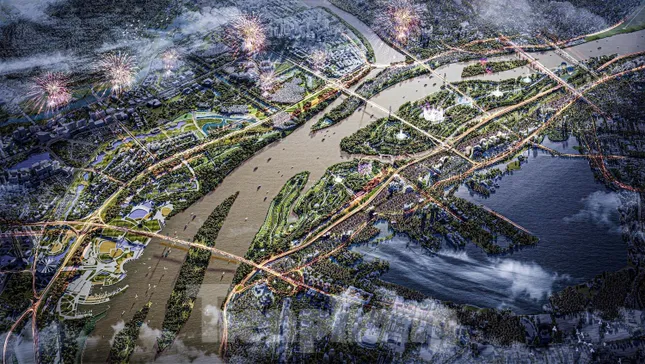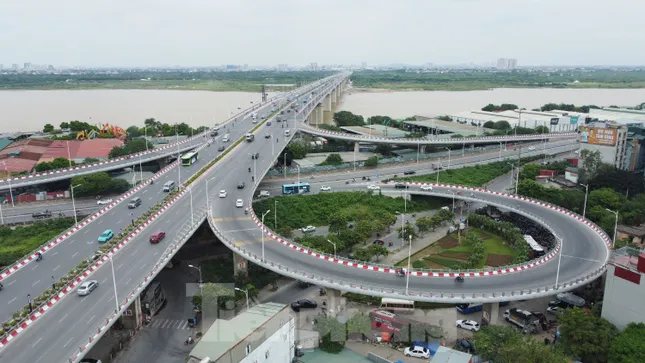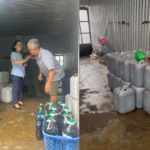The Deo Ca – Van Phu joint venture representative specifically stated that based on the onsite survey and analysis of the traffic system, terrain, and ecology, the joint venture has proposed a detailed and comprehensive plan for the “Red River Boulevard and Landscape” project. According to the proposal, this strategic “backbone” with a scale of approximately 7,800 ha will have a total length of about 40 km (20 km on each bank of the Red River).
The joint venture also announced that the proposal has been approved by the Hanoi People’s Committee for research and proposal of the project in the form of a public-private partnership (PPP) and a build-transfer (BT) contract.

Proposed perspective of the “Red River Boulevard and Landscape” by the joint venture.
Specifically, the road on the right bank of the Red River (following the water flow – towards the inner city) will start at Hong Ha Bridge and end at Me So Bridge (in the future). The road on the left bank of the Red River (following the water flow – towards Dong Anh and Gia Lam) will start at the intersection with Ring Road 4 at Hong Ha Bridge and end at the project of the road connecting cultural heritage, tourism, and economic development along the Red River.
As proposed, the Red River landscape boulevard (on both sides) includes 22 km of viaducts, 7.6 km of parallel roads, 2.3 km of tunnels, and a cross-sectional width ranging from 4 to 6 lanes. The clusters of parks, entertainment areas, and iconic structures that will be the highlights of the capital and the landscape on both banks of the river span about 3,000 ha. These clusters can host a variety of traditional and modern cultural activities and traditional craft villages.
Regarding the main objective of the project, the joint venture informed that it aims to transform the Red River area into a new ecological and cultural axis, while also creating the largest public space in Hanoi, contributing to enhancing the city’s appearance.
According to the joint venture, the project will create a new development milestone: the “Red River Miracle,” which will contribute to the promotion of the Red River civilization and the thousand-year-old capital. Looking ahead, the project will help address the issue of the “city turning its back on the river,” a long-standing reality in the capital. Additionally, it will enhance transportation connectivity and develop a multifunctional urban space, meeting the needs of residents’ daily lives, businesses, and entertainment.
Project concerns about flood diversion and dike protection
In terms of international connectivity, the joint venture stated that the route will provide the fastest access for international visitors traveling from Gia Lam Airport (or Gia Binh, if the project is realized) to the city center via Tu Lien Bridge.
“The boulevard is not just a transportation link between Hanoi and Hung Yen and Phu Tho but also a vibrant ecological and cultural corridor, featuring terraced parks, walkways, riverside squares, service-tourism complexes, and community spaces,” the proposal explained.
The Deo Ca – Van Phu joint venture committed to consulting and studying the experiences of cities that have successfully planned rivers within their urban areas. They will also cooperate with partners who have implemented similar projects to ensure the best outcome for the Red River Boulevard and Landscape project. The joint venture group will also self-finance the preparation of the project proposal.

Vinh Tuy Bridge (Hanoi) is one of the bridges on the Red River that the proposed river landscape route is expected to cross and connect. Photo: Anh Trong
Commenting on the above proposal, a representative of the Hanoi Department of Construction stated that the department has not yet received any official instructions from the city. However, as the proposal involves a traffic axis running along both banks of the Red River, the specialized agency needs to carefully study the proposal and conduct a field survey to assess its compatibility with the master plan, especially with the Law on Dikes and Dykes.
Architect Tran Huy Anh, a member of the Executive Board of the Hanoi Architects Association, welcomed the ideas for developing Hanoi’s urban infrastructure, including transportation.
Regarding the proposed research on the boulevard and landscape axis on both banks of the Red River, Architect Tran Huy Anh noted that the information and perspective show that the planned roads are entirely within the flood diversion corridor and dike protection corridor (Red River). Moreover, in addition to constructing the two roads, the project also intends to utilize a significant amount of land in the riverine and dike corridor, amounting to approximately 7,800 ha.
According to Architect Tran Huy Anh, according to the Law on Dikes and Dykes and the approved master plan for both banks of the Red River by the Prime Minister, any construction or renovation activities that exceed the height of the riverbank, dike, and within the flood diversion and dike protection corridors are not permitted.
“Thus, the project proposal has ‘encroached’ on the flood diversion and dike protection corridors as stipulated in the Law on Dikes and Dykes, but the investor has not yet provided a solution,” Architect Tran Huy Anh expressed his concern.
“Hanoi Authorities Seize 2,600 Liters of Untraceable Fish Sauce, Fining Business Establishment VND 50 Million”
The Hanoi People’s Committee Chairman has imposed an administrative fine of VND 50 million on the owner of a business establishment for trading 2,600 liters of fish sauce of unknown origin.
The President on a Special Milestone: Implementing a Two-Tier Government Structure, Effective Immediately.
“Today marks an extraordinary milestone for the city of Hanoi and Vietnam as a whole. From this day forward, the country will consist of just 34 provinces and cities, along with 3,321 wards, communes, and special districts. This is a significant step forward, and we are proud to witness this historic moment.”
Appointing New Secretaries and Chairpersons for 126 Wards and Communes in Hanoi
On the morning of June 30, the leadership of Hanoi city bestowed organizational and personnel decisions to 126 newly-established wards and communes, as part of the city’s administrative unit reorganization. This marks a significant step in the city’s journey towards a more efficient and streamlined governance structure.





















